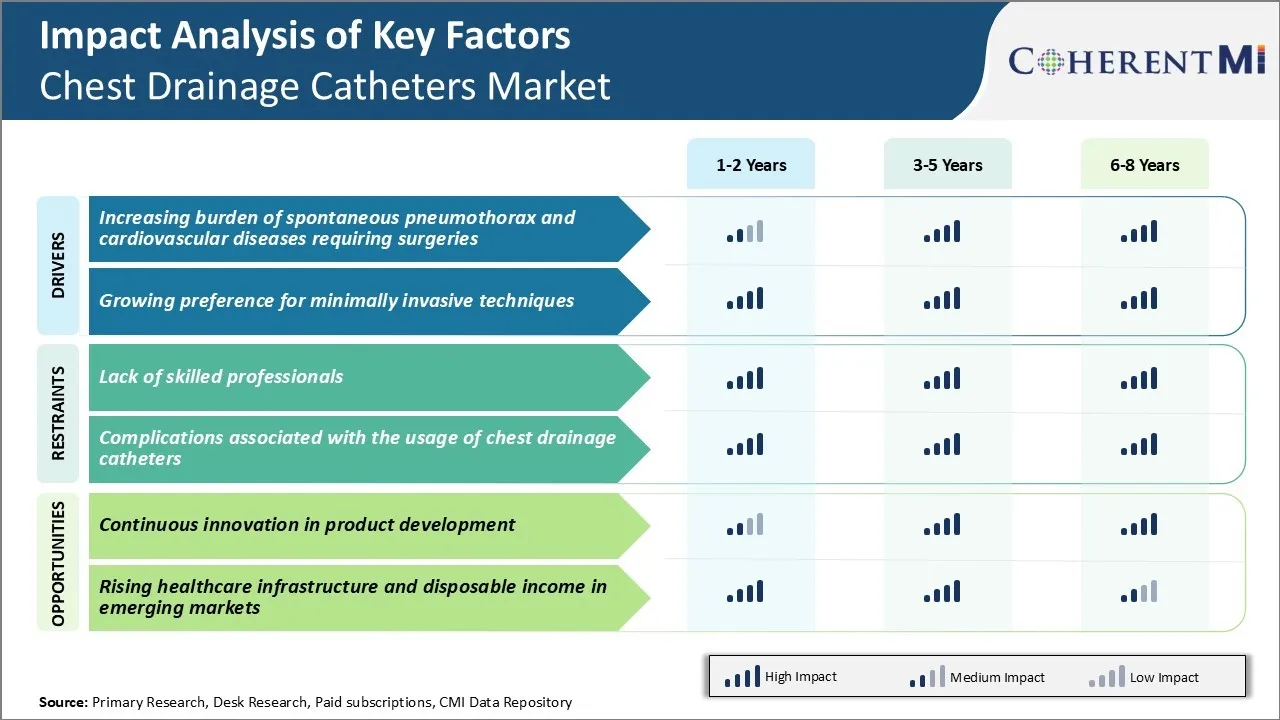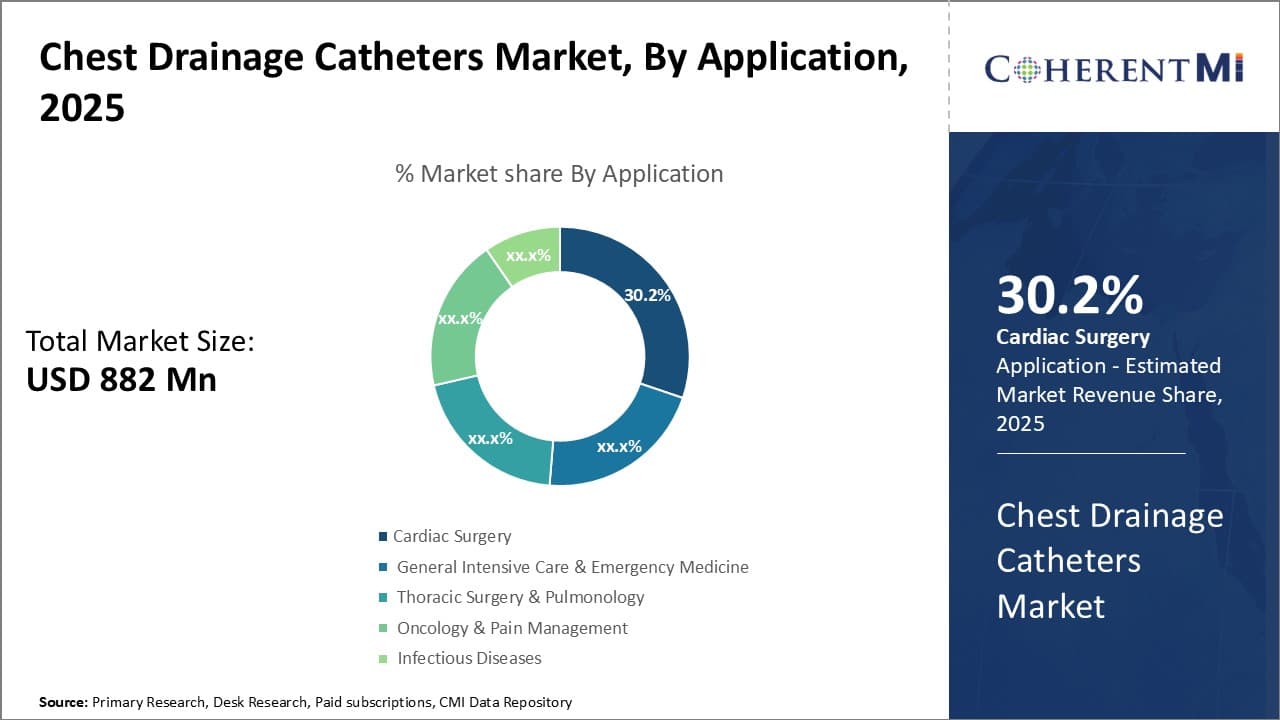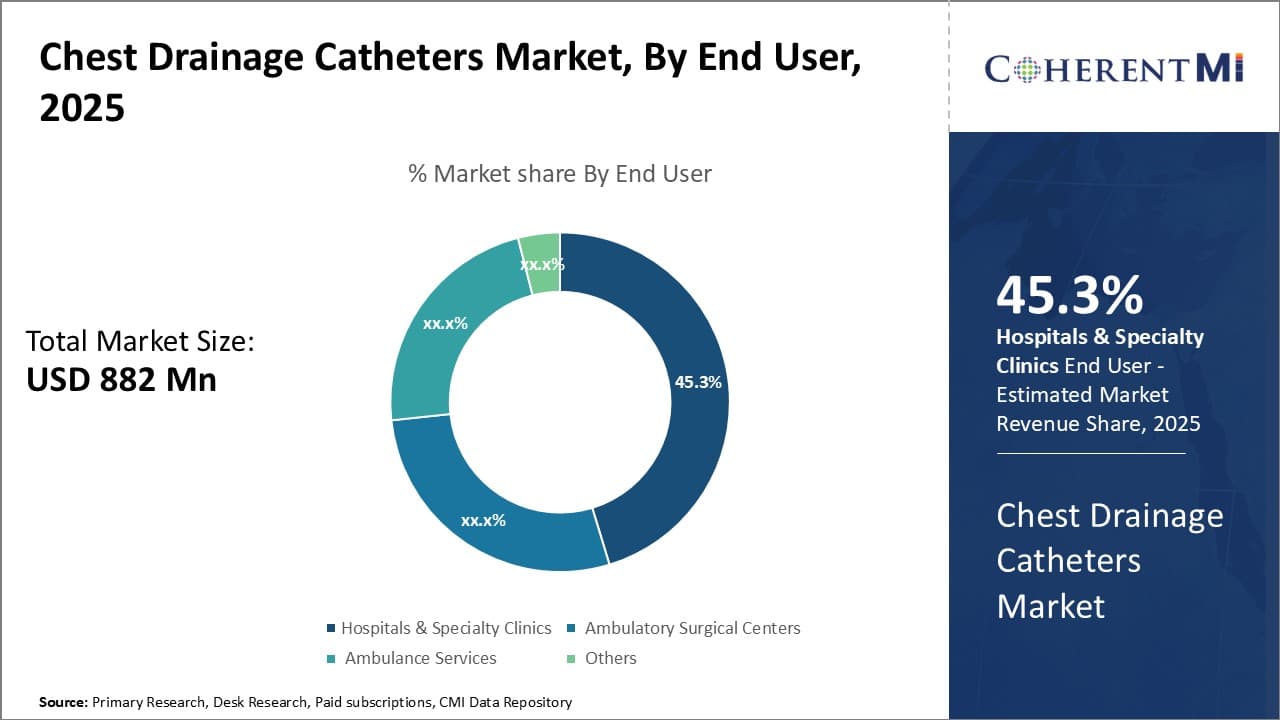

The chest drainage catheters market is estimated to be valued at USD 882.0 Mn in 2025 and is expected to reach USD 1241.1 Mn by 2032, growing at a compound annual growth rate (CAGR) of 5.00% from 2025 to 2032. Chest drainage catheters are seeing increased demand owing to the rising prevalence of diseases such as lung cancers and cardiac conditions which require post-surgery insertion of chest tubes.
Market Size in USD Mn
CAGR5.00%
| Study Period | 2025-2032 |
| Base Year of Estimation | 2024 |
| CAGR | 5.00% |
| Market Concentration | Medium |
| Major Players | Getinge, Sterimed Group, Polymedicure, Advin Health Care, ANGIPLAST PRIVATE LIMITED and Among Others |
Market Driver - Increasing Burden of Spontaneous Pneumothorax and Cardiovascular Diseases Requiring Surgeries
Spontaneous pneumothorax and cardiovascular diseases have been steadily rising over the past few decades. It is estimated that the overall occurrence rate of spontaneous pneumothorax is about 7 to 18 cases per 100,000 individuals annually worldwide.
The condition occurs more commonly in males and is frequently reported in tall, thin young adults and those with underlying lung abnormalities like cystic fibrosis or chronic obstructive pulmonary disease (COPD). The increasing prevalence of these underlying risk factors is contributing to the rising incidence of spontaneous pneumothorax globally.
On the other hand, cardiovascular diseases, primarily coronary heart disease and stroke, remain the leading cause of mortality around the world. Conditions like coronary artery disease often require bypass surgery to divert blood around blocked arteries and improve blood flow to the heart.
Lung diseases as well as cardiovascular conditions frequently necessitate insertion of chest drainage catheters during or after surgical procedures to drain fluid or air from the pleural space and prevent respiratory complications. This is likely to accentuate the demand for chest drainage catheters in the coming years.
Market Driver - Growing Preference for Minimally Invasive Techniques
Across the medical industry, there is a noticeable shift toward utilizing minimally invasive procedures that can reduce recovery times, trauma, and costs for patients. Compared to traditional open surgeries, minimally invasive approaches offer advantages like smaller incisions, lesser blood loss, lower risk of surgical site infections, and quicker return to normal activities.
In thoracic surgeries, video-assisted thoracoscopic surgeries (VATS) are replacing higher risk open pulmonary resections for treating various lung conditions. VATS requires only small incisions and insertion of narrow tubes or ports rather than a large surgical cut. Similarly, cardiovascular procedures are increasingly performed using catheter-based techniques rather than open-chest operations.
Given their small size and flexibility, chest drainage catheters are perfectly suited for minimally invasive surgeries. They help to drain fluids from the chest cavity through narrow incisions without requiring a large opening. As more physicians adopt minimally invasive methods, there is a corresponding shift in preference from rigid chest tubes to flexible drainage catheters that complement these modern surgical techniques. Overall, the widespread transition to minimally invasive therapies in thoracic and cardiac surgeries will drive increasing utilization and demand for chest drainage catheters.
 To learn more about this report, Download Free Sample Copy
To learn more about this report, Download Free Sample Copy
Market Challenge - Lack of Skilled Professionals
One of the major challenges currently being faced by the Chest Drainage Catheters market is the lack of skilled professionals who can perform procedures related to insertion and management of chest drainage catheters. Proper insertion and management of chest drains requires technical skill and expertise as it involves placing tubes into the chest cavity to drain fluid or air. Any mistake during the procedure can have severe medical consequences for the patient such as injury to organs or infections.
However, there is a significant shortage of thoracic surgeons and trained nursing staff who have been specially trained to handle such procedures. While demand for chest drainage is growing due to the increasing incidence of complications like pneumothorax or pleural effusion, there is a lack of adequate numbers of trained personnel to meet this demand.
This skill gap is restricting wider adoption of chest drainage techniques and affecting the potential growth of the chest drainage catheters market. Medical device companies and healthcare institutions need to focus on implementing specialized training and certification programs to develop more expertise in this field.
Market Opportunity - Continuous Innovation in Product Development
One major opportunity available for the growth of the Chest Drainage Catheters market is the scope of continuous innovation in product development. As the procedures related to chest drainage become more common, product developers in the market are focusing their R&D efforts on introducing newer and advanced versions of chest drainage catheters.
There is ongoing research on developing smart chest drainage devices that can monitor parameters like fluid flow digitally and alert medical staff in case of any obstruction or emergency. Companies are also working on designing more patient-friendly chest drain systems with enhanced features like reduced pain of insertion and increased comfort.
The availability of innovative product variants with additional capabilities can help address more clinical applications as well as provide improved patient outcomes. This continued innovation and technological advancements in product development will help expand the market potential for chest drainage catheters in the coming years.
Product innovation strategies: Developing innovative products with improved features has helped players gain an edge. For example, Medtronic launched its Securea Chest Drainage Catheter in 2018 which contains a one-way valve to prevent retrograde flow of fluid and maintain suction. This catheter has dual distal eyes to prevent clogging and maintain drainage. Such innovative features enhanced patient outcomes and increased its market share.
Merger & acquisition strategies: Acquiring competitors has allowed players to expand their product portfolio and geographic footprint. For example, in 2019, Teleflex acquired Essential Medical, a leading provider of chest drainage catheters. This acquisition strengthened Teleflex's position in the chest drainage market by adding complementary products to its existing drain portfolio.
Marketing strategies: Aggressive marketing activities have helped raise brand awareness. For instance, Medtronic spent over $6 billion on promotional & marketing activities between 2016-20. This helped promote its brand name and chest drainage products like the Pleur-evac to doctors and hospitals globally. Such heavy spending on marketing paid rich dividends with increased sales and market share gains.
Distribution strategies: Establishing strong distribution networks is crucial. Atrium Medical expanded its distributor relationships and now supplies its chest drainage products to over 75 countries.
 To learn more about this report, Download Free Sample Copy
Insights, By Application: Increasing Prevalence of Cardiac Diseases Highlights Importance of Cardiac Surger
To learn more about this report, Download Free Sample Copy
Insights, By Application: Increasing Prevalence of Cardiac Diseases Highlights Importance of Cardiac Surger
Cardiac surgery is the largest application segment, which is projected to hold 30.2% share of the chest drainage catheters market in 2025. The increasing prevalence of cardiac diseases such as coronary artery disease, heart failure, and congenital heart defects has been a major driver. Coronary artery disease remains the leading cause of mortality worldwide.
As the population ages globally, the burden of heart disease continues to grow dramatically. Surgical procedures such as coronary artery bypass grafting and valve replacement surgeries require chest tubes to be placed post-operatively to drain fluid from the pleural space and re-expand the lung. Advances in minimally invasive cardiac surgery techniques have also contributed to growth, as video-assisted thoracoscopic surgery often employs small incision chest drainage.
Rise in risk factors for heart disease such as obesity, diabetes, and hypertension has fueled cardiac surgery volumes. More people with these conditions are now eligible for procedures due to improvements in anesthesia, surgical methods and postoperative care. This has expanded the eligible patient pool.
Additionally, improved access to healthcare in developing nations through public insurance schemes is enabling more people to get treated. Growing expertise of cardiac surgeons in complex revascularization and valve repair/replacement through continued medical training also supports the market. In the long run, as more comprehensive screening programs are implemented, preventable cases of heart disease may moderate the growth rates slightly by reducing surgery numbers.
 To learn more about this report, Download Free Sample Copy
To learn more about this report, Download Free Sample Copy
Insights, By End User: Hospitals & Specialty Clinics Witness Large Patient Volumes and Complex Procedures
The largest end user segment for chest drainage catheters is hospitals and specialty clinics. They are estimated to account for 45.3% of the market share in 2025. This is because hospitals manage the majority of cardiac surgery, thoracic surgery and critical care cases globally. Most complex cardiac procedures requiring postoperative drainage are performed in hospitals that have specialized cardiac surgical units, intensive care facilities and cardiac catheterization labs. These settings also offer round the clock availability of trained physicians, nursing staff as well as backup support in case of post-surgical complications or emergencies.
Furthermore, hospitals have well-established procurement systems enabling bulk purchases of disposable drainage devices for various surgical specialties. This bulk buying translates into volume-based discounts for hospitals.
While smaller non-critical cases are also being shifted to ambulatory surgical centers, most life-threatening conditions still require inpatient hospital management. The multi-specialty nature of large hospitals allows for efficient coordination of care between cardiac surgeons, pulmonologists, intensivists and other services. This streamlined approach from pre-op evaluation to post-op monitoring favors better outcomes.
The rising acuity and complexity of cardiac patients with multiple comorbidities reinforces the important role of hospitals. Ambulatory centers and physician offices lack intensive care facilities to handle respiratory deterioration during the critical initial drainage period. This makes hospitals the default and largest end user segment currently.
The major players operating in the Chest Drainage Catheters Market include Getinge, Teleflex Incorporated, Sterimed Group, Cook, Cardinal Health, Redax, Medela AG, LivaNova PLC, Mediplus, and Utah Medical Products, Inc.
Would you like to explore the option of buying individual sections of this report?
Manisha Vibhute is a consultant with over 5 years of experience in market research and consulting. With a strong understanding of market dynamics, Manisha assists clients in developing effective market access strategies. She helps medical device companies navigate pricing, reimbursement, and regulatory pathways to ensure successful product launches.
Chest Drainage Catheters Market is segmented By Application (Cardiac Surgery, General Intensive Care...
Chest Drainage Catheters Market
How big is the chest drainage catheters market?
The chest drainage catheters market is estimated to be valued at USD 882.0 Mn in 2025 and is expected to reach USD 1,166 Mn by 2032.
What are the key factors hampering the growth of the chest drainage catheters market?
The lack of skilled professionals and complications associated with the usage of chest drainage catheters are the major factors hampering the growth of the chest drainage catheters market.
What are the major factors driving the chest drainage catheters market growth?
The increasing burden of spontaneous pneumothorax and cardiovascular diseases requiring surgeries, and growing preference for minimally invasive techniques are the major factors driving the chest drainage catheters market.
Which is the leading application in the chest drainage catheters market?
The leading application segment is cardiac surgery.
Which are the major players operating in the chest drainage catheters market?
Getinge, Teleflex Incorporated, Sterimed Group, Cook, Cardinal Health, Redax, Medela AG, LivaNova PLC, Mediplus, and Utah Medical Products, Inc. are the major players.
What will be the CAGR of the chest drainage catheters market?
The CAGR of the chest drainage catheters market is projected to be 5.00% from 2025-2032.